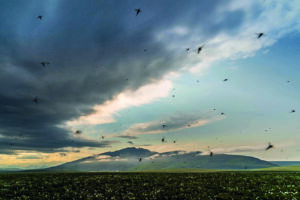Photo credit: Matthew Richardson. CC BY-NC-ND 2.0 via Flickr.com
The summer siege
Mosquitoes, forage and the future of Arctic caribou
Climate change in the Arctic is altering summer forage and insect conditions for migratory caribou. Warmer, earlier summers can mean increased forage quantity, but reduced quality. At the same time, these conditions can trigger earlier, more intense periods of insect harassment. As HEATHER JOHNSON writes, these changes are associated with shifts in migratory caribou behaviours and distributions, along with their ability to survive and reproduce.
Under the midnight sun, the Arctic tundra is transformed. The frozen, dark, windswept landscapes of winter are remade by blooming cottongrass, the arrival of millions of birds, the buzzing of mosquitoes, and the return of thousands of migratory caribou. These caribou have just completed one of the longest land migrations on Earth, travelling hundreds of kilometres to reach their calving and summer grounds at the top of North America.
Researchers initially speculated that warmer summers in the Arctic would benefit migratory caribou. After all, these are herbivores that spend most of the year in extreme winter conditions, surviving on lichens and dead vegetation. Shouldn’t a longer, warmer summer be better for them?
However, paradoxically, we are seeing the opposite. Even as the Arctic has become “greener,” with more productive growing seasons, most migratory caribou herds across North America have declined. This pattern has raised urgent questions about the influence of summer habitat on caribou and how their populations may be affected in the future.

Photo Credit: Alexis Bonogofsky
Changing summer conditions
The Arctic summer provides caribou with an abundance of fresh, green plants that supply the fat and protein they need to recover from winter and fuel the next generation of calves. Although summer is an important time for accumulating these nutrients, it is also when caribou are harassed by insects—primarily mosquitoes and oestrid flies (bot or warble flies). When harassment is severe, caribou spend less time eating and more time fleeing to cooler, windier areas.
The problem: while these areas offer relief from the bugs, they also offer less food.
Both summer forage and insect harassment shape caribou behaviour—and both, in turn, are strongly affected by climate conditions. Longer, warmer Arctic summers alter the abundance, quality and timing of summer forage available for caribou while also likely reducing their opportunity to eat because of earlier, more intense periods of insect harassment.
To better understand how these conditions may affect caribou in the future, the US Geological Survey worked with partners to conduct research on the Central Arctic herd on the North Slope of Alaska. We collected data on the quantity and quality of important summer forage (plants like willow, dwarf birch and tussock cottongrass) and how these changed throughout the season while also modelling mosquito activity based on wind and temperature data. Additionally, we put GPS tags on adult female caribou to see how their movements, habitat use, survival and reproduction responded to annual changes in summer conditions.
Caribou responses
We found that earlier, warmer summers were associated with greater quantities (in terms of biomass) of some forage plants for caribou, but also with reduced forage protein—important for reproduction. Also, earlier, warmer summers were predicted to come with earlier and more severe periods of mosquito harassment. Importantly, we found that caribou behaviour, survival and rates of reproduction responded to changes in summer habitat conditions.
Early in the summer, caribou sought areas with higher forage quality, especially protein. Later in the summer, after plants had matured and protein declined, caribou shifted to areas with higher forage biomass, enabling fat storage. They also avoided areas predicted to have higher mosquito harassment—more than doubling their movement rates when harassment was high as they sought insect relief.
In fact, intense mosquito harassment hindered caribou from foraging effectively and reduced their use of high-quality plants. These responses drove major shifts in caribou distributions, with the herd moving north to cooler, windier coastal areas early in the summer and shifting to southern inland areas later in the season.
Female caribou survived better when they had access to higher forage biomass, and they were more likely to produce calves after summers with higher forage protein. But greater mosquito harassment reduced both female survival and reproduction.
—Heather Johnson, Research Wildlife Biologist, US Geological Survey
We also found that year-to-year changes in summer conditions had consequences for caribou survival and reproduction. Female caribou survived better when they had access to higher forage biomass, and they were more likely to produce calves after summers with higher forage protein. But greater mosquito harassment reduced both female survival and reproduction. In addition, we found that summers with both low forage protein and high harassment had a particularly pronounced effect at reducing calf production the following year. These conditions, associated with earlier, warmer summers, are expected to occur more frequently in the future.
Our research is showing how climate change is affecting summer habitat for migratory Arctic caribou, leading to shifts in their behaviour, distributions and demographics. We are continuing to investigate these relationships in other caribou herds, using additional data types and new technologies. Collectively, this work will be used to anticipate how caribou populations may respond to future environmental conditions and to identify important management and conservation strategies.